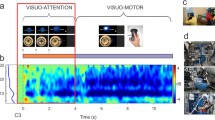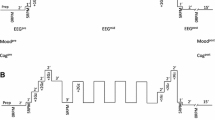Abstract
Previous studies showed that changing forces of gravity as they typically occur during parabolic flights might be responsible for adaptional processes of the CNS. However, until now it has not been differentiated between primary influences of weightlessness and secondary influences due to psycho-physiological factors (e.g., physical or mental strain). With the aim of detecting parabolic flight related changes in central cortical activity, a resting EEG was deduced in 16 subjects before, during and after parabolic flights. After subdividing EEG into α-, β-,δ- and θ-wave bands, an increase in β-power was noticeable inflight, whereas α1-power was increased postflight. No changes could be observed for the control group. To control possible effects of cortical activation, a manual tracking task with mirror inversion was performed during either the phase of weightlessness or during the normal gravity phase of a parabolic flight. No differences in performance nor in adaptation could be observed between both groups. A third group, performing under normal and stress-free conditions in a lab showed similar tracking values. We assume that the specific increase in brain activity is a sign of an increase in arousal inflight. This does support previous assumptions of non-specific stressors during parabolic flights and has to be considered as a relevant factor for experiments on central nerve adaptation. Although no influences of stress and/or weightlessness on motor perfromance and adaptation could be observed, we suggest that an “inflight” control group seems to be more adequate than a laboratory control group to investigate gravity-dependent changes in motor control.



Similar content being viewed by others
References
Andres FG, Gerloff C (1999) Coherence of sequential movements and motor learning. J Clin Neurophysiol 16:520–527
Augurelle AS, Penta M, White O, Thonnard JL (2003) The effects of a change in gravity on the dynamics of prehension. Exp Brain Res 148: 533–540
Blum J, Lutz K, Jancke L (2007) Coherence and phase locking of intracerebral activation during visuo- and audio-motor learning of continuous tracking movements. Exp Brain Res 182(1):59–69
Bock O, Abeele S, Eversheim U (2003) Sensorimotor performance and computational demand during short-term exposure to microgravity. Aviat Space Environ Med 74:1256–1262
Bock O, Fowler B, Comfort D (2001) Human sensorimotor coordination during spaceflight: an analysis of pointing and tracking responses during the “Neurolab” space shuttle mission. Aviat Space Environ Med 72:877–883
Bock O, Howard IP, Money KE, Arnold KE (1992) Accuracy of aimed arm movements in changed gravity. Aviat Space Environ Med 63:994–998
Bonnet MH, Arand DL (2001) Impact of activity and arousal upon spectral EEG parameters. Physiol Behav 74:291–298
Buckley TM, Schatzberg AF (2005) On the interactions of the hypothalamic–pituitary–adrenal (HPA) axis and sleep: normal HPA axis activity and circadian rhythm, exemplary sleep disorders. J Clin Endocrinol Metab 90:3106–3114
Cheron G, Leroy A, De Saedeleer C, Bengoetxea A, Lipshits M, Cebolla A, Servais L, Dan B, Berthoz A, McIntyre J (2006) Effect of gravity on human spontaneous 10-Hz electroencephalographic oscillations during the arrest reaction. Brain Res 1121:104–116
Cooper R, Osselton JW, Shaw JC (1984) Elektroenzephalographie. Fischer, Stuttgart
Davidson RJ (1988) EEG measures of cerebral asymmetry: conceptual and methodological issues. Int J Neurosci 39:71–89
De Metz K, Quadens O, De Graeve M (1994) Quantified EEG in different G situations. Acta Astronaut 32:151–157
Dussault C, Jouanin JC, Philippe M, Guezennec CY (2005) EEG and ECG changes during simulator operation reflect mental workload and vigilance. Aviat Space Environ Med 76:344–351
Ehlers CL, Reed TK, Henriksen SJ (1986) Effects of corticotropin-releasing factor and growth hormone-releasing factor on sleep and activity in rats. Neuroendocrinology 42:467–474
Etnier JL, Whitwer SS, Landers DM, Petruzello SJ, Salazar W (1996) Changes in electroencephalographic activity associated with learning a novel motor task. Res Q Exerc Sport 67:272–279
Fowler B, Manzey D (2000) Summary of research issues in monitoring of mental and perceptual-motor performance and stress in space. Aviat Space Environ Med 71:A76–A77
Genik RJ, Green CC, Graydon FX, Armstrong RE (2005) Cognitive avionics and watching spaceflight crews think: generation-after-next research tools in functional neuroimaging. Aviat Space Environ Med 76:B208–B212
Guger C, Domej W, Lindner G, Edlinger G (2005) Effects of cable car ascent to 2,700 m on mean EEG frequency and event-related desynchronization (ERD). Wien Med Wochenschr 155:143–148
Halsband U, Lange RK (2006) Motor learning in man: a review of functional and clinical studies. J Physiol Paris 99:414–424
Hermsdörfer J, Marquardt C, Philipp J, Zierdt A, Nowak D, Glasauer S, Mai N (2000) Moving weightless objects: grip force control during microgravity. Exp Brain Res 132:52–64
Hermsdörfer J, Marquardt C, Philipp J, Zierdt A, Nowak D, Glasauer S, Mai N (1999) Grip forces exerted against stationary held objects during gravity changes. Exp Brain Res 126:205–214
Heuer H, Manzey D, Lorenz B, Sangals J (2003) Impairments of manual tracking performance during spaceflight are associated with specific effects of microgravity on visuomotor transformations. Ergonomics 46:920–934
Jasper HH (1958) The ten-twenty electrode system of the international federation. Electroencephalogr Clin Neurophysiol Suppl 35:371–375
Jüngling S, Bock O, Girgenrath M (2002) Speed-accuracy trade-off of grasping movements during microgravity. Aviat Space Environ Med 73:430–435
Kramer AF (1991) Physiological metrics of mental workload: a review of recent progress. In: Damos DL (ed) Multiple-task performance. Taylor & Francis, London, pp 279–328
Lackner JR, DiZio P (1992) Gravitoinertial force level affects the appreciation of limb position during muscle vibration. Brain Res 592:175–180
Lackner JR, Graybiel A (1981) Illusions of postural, visual, and aircraft motion elicited by deep knee bends in the increased gravitoinertial force phase of parabolic flight. Exp Brain Res 44:312–316
Landers DM, Han M, Salazar W, Petruzzello SJ (1994) Effects of learning on electroencephalographic and electrocardiographic patterns in novice archers. Int J Sport Psychol 25:313
Lindsley DB (1960) Attention, consciousness, sleep and wakefulness. In: Magoun (ed) Handbook of physiology. American Physiological Society, Washington, pp 1553–1593
Manzey D, Lorenz TB, Heuers H, Sangals J (2000) Impairments of manual tracking performance during spaceflight: more converging evidence from a 20-day space mission. Ergonomics 43:589–609
Mcdonald AJ, Mascagni F, Guo L (1996) Projections of the medial and lateral prefrontal cortices to the amygdala: a Phaseolus vulgaris leucoagglutinin study in the rat. Neuroscience 71:55–75
Money KE, Cheung BS (1991) Alterations of proprioceptive function in the weightless environment. J Clin Pharmacol 31:1007–1009
Pletser V, Quadens O (2003) Degraded EEG response of the human brain in function of gravity levels by the method of chaotic attractor. Acta Astronaut 52:581–589
Prinzel LJ, Parasuraman R, Pope AT, Freeman FG, Scerbo MW, Mikulka PJ (2003) Three experiments examining the use of electroencephalogram, event-related potentials, and heart-rate variability for real-time human-centered adaptive automation design. Langley Research Center, Hampton, VA 23681-2199, National Aeronautics and Space Administration
Prinzel LJ, Pope AT, Freeman FG, Scerbo MW, Mikulka PJ (2001) Empirical analysis of EEG and ERPs for psychophysiological adaptive task allocation. Langley Research Center, Hampton, VA 23681-2199, National Aeronautics and Space Administration
Saletu B, Krieger P, Grunberger J, Schanda H, Sletten I (1977) Tandamine—a new norepinephrine reuptake inhibitor. Clinical, psychometric and quantitative EEG studies in depressed patients. Int Pharmacopsychiatry 12:137–152
Schmah M, Horn E (2005) Neurophysiological long-term recordings in space: experiments Scorpi and Scorpi-T. Gravit Space Biol Bull 18:95–96
Schneider S, Brummer V, Gobel S, Carnahan H, Dubrowski A, Struder HK (2007) Parabolic flight experience is related to increased release of stress hormones. Eur J Appl Physiol 100:301–308
Sesack SR, Deutch AY, Roth RH, Bunney BS (1989) Topographical organization of the efferent projections of the medial prefrontal cortex in the rat: an anterograde tract-tracing study with Phaseolus vulgaris leucoagglutinin. J Comp Neurol 290:213–242
Smith ME, Gevins A, Brown H, Karnik A, Du R (2001) Monitoring task loading with multivariate EEG measures during complex forms of human–computer interaction. Hum Factors 43:366–380
Sterman MB, Mann CA (1995) Concepts and applications of EEG analysis in aviation performance evaluation. Biol Psychol 40:115–130
Wilson GF, Reis GA, Tripp LD (2005) EEG correlates of G-induced loss of consciousness. Aviat Space Environ Med 76:19–27
Zuckermann M (1991) Psychobiology of personality. CambridgeUniversity Press, New York
Acknowledgments
We would like to thank all our subjects for taking part in this study. Our special thanks goes to the team at NOVESPACE for giving us all the support we needed. The comments of two unknown reviewers on the first version of this manuscript are much appreciated. This study was made possible by a grant from the German Space Agency (DLR) 50WB0519.
Author information
Authors and Affiliations
Corresponding author
Rights and permissions
About this article
Cite this article
Schneider, S., Brümmer, V., Mierau, A. et al. Increased brain cortical activity during parabolic flights has no influence on a motor tracking task. Exp Brain Res 185, 571–579 (2008). https://doi.org/10.1007/s00221-007-1187-6
Received:
Accepted:
Published:
Issue Date:
DOI: https://doi.org/10.1007/s00221-007-1187-6




